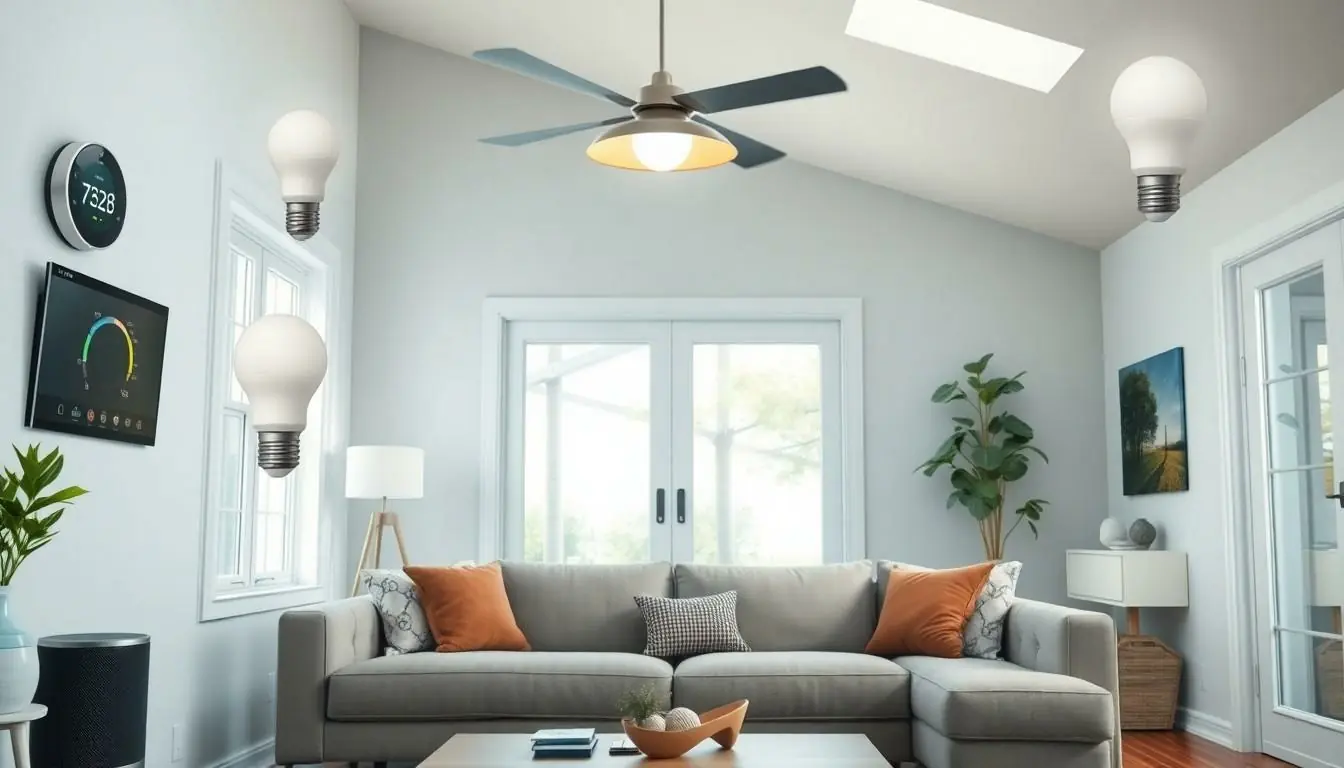In a world where homes are getting smarter by the minute, why not let your living space join the tech revolution? DIY smart home projects are not just for tech wizards; they’re for anyone who wants to sprinkle a bit of magic into their daily life without breaking the bank. Imagine controlling your lights, thermostat, and even your coffee maker with just a few taps on your phone. Sounds like a scene from a sci-fi movie, right?
Table of Contents
ToggleOverview Of DIY Smart Home
DIY smart home projects offer an engaging way for households to enhance their living environments. Individuals can customize devices, facilitating seamless interactions among appliances. Smart lights adjust brightness automatically based on activities, ensuring optimal comfort.
Homeowners leverage smart thermostats to optimize energy use, resulting in cost savings. Voice-activated assistants simplify daily tasks, allowing easy control of various devices from anywhere within the home. Security cameras provide real-time monitoring, ensuring enhanced safety for families.
Integrating smart technology into the home promotes convenience and efficiency. Many enthusiasts start with basic setups, such as smart plugs or lighting systems, gradually progressing to comprehensive configurations. By exploring platforms like Raspberry Pi or Arduino, they gain deeper insight into scripting and automation.
A variety of smart home products exist, each serving specific functions. These include smart locks for increased security, smart appliances that streamline chores, and smart speakers that play music or provide information. The accessibility of these devices has increased considerably, making DIY projects feasible for a broader audience.
Many users share their DIY experiences online, creating a wealth of resources and tutorials. Videos on platforms like YouTube and guides on dedicated websites serve as valuable tools for novices. Community forums help troubleshoot issues, fostering a collective growth in knowledge and skills.
Adopting a DIY approach embodies creativity and self-sufficiency, enabling individuals to tailor their smart home experience to personal preferences. As technology progresses, the possibilities for innovation expand, making DIY smart home projects an exciting endeavor for everyone.
Benefits Of DIY Smart Home Systems

DIY smart home systems provide multiple advantages, making homes more efficient and enjoyable. Cost efficiency and customization options stand out as key benefits.
Cost Efficiency
Investing in DIY smart home technology leads to significant savings. Smart devices often reduce energy consumption, lowering utility bills. For instance, smart thermostats can adapt to usage patterns, maximizing comfort while minimizing expenses. Homeowners control devices remotely, turning off lights or appliances when not in use. Many products offer affordability, with prices decreasing as technology evolves. Moreover, DIY installations avoid costly professional service fees, allowing users to create their systems within budget constraints.
Customization Options
Flexibility in choosing smart home components enhances personalization. Individuals can select devices that suit their specific needs and preferences, crafting a unique ecosystem. One homeowner might prioritize security features, while another focuses on energy efficiency. Integrations with various platforms, like Amazon Alexa or Google Home, simplify control over different devices. Custom routines enable tailored experiences, allowing adjustments based on time of day or activities. Ultimately, this level of personalization improves user satisfaction, helping residents create their ideal living environments.
Essential Components For A DIY Smart Home
DIY smart home projects start with essential components that enhance automation and convenience. Here are key elements to consider.
Smart Hubs
Smart hubs serve as the central point for device connectivity. They manage communication between different smart devices, ensuring seamless integration. Platforms like Samsung SmartThings and Amazon Echo offer compatibility with numerous products. Users can issue voice commands or monitor devices through apps. A reliable hub improves overall system responsiveness and coordination.
Smart Lighting
Smart lighting systems provide adjustable brightness and color settings. Users can control lights remotely through smartphone apps or voice commands. For example, Philips Hue and LIFX offer versatile options that fit various needs. Smart bulbs can respond to schedules, automatically turning on or off at specific times. Enhancements such as motion sensors add further convenience, activating lights when someone enters a room.
Smart Security
Smart security systems enhance home safety and surveillance. Cameras, doorbells, and window sensors work together to monitor properties in real-time. Users receive alerts on their smartphones when motion is detected or doors are opened. Brands like Ring and Arlo provide reliable options for monitoring indoor and outdoor areas. Enhanced features such as cloud storage and night vision ensure thorough protection.
Smart Thermostats
Smart thermostats optimize heating and cooling based on user preferences. They learn household patterns, adjusting the temperature for comfort and energy savings. Brands like Nest and Ecobee offer programmable features, allowing remote adjustments from mobile devices. Users can analyze energy usage to identify savings opportunities. Smart thermostats contribute to a more efficient and comfortable home environment.
Getting Started With Your DIY Smart Home
Creating a DIY smart home begins with thoughtful planning and a solid understanding of available devices. Focus on the layout and functionality to maximize convenience.
Planning Your Layout
Decide on the areas in your home where smart devices will provide the most benefit. Consider high-traffic zones like living rooms and kitchens for devices such as smart speakers and lighting. Assess the wiring and connectivity to ensure seamless communication among devices. Allocate dedicated power outlets for smart plugs and chargers to prevent clutter. Layout planning enhances user experience and optimizes the system’s efficiency.
Choosing the Right Devices
Research various smart home products suited for your lifestyle. Look for devices that integrate well with existing home networks. Consider smart lighting, which allows for custom brightness and color adjustments. Select security cameras with mobile alerts to ensure real-time monitoring. Evaluate smart thermostats for their energy-saving capabilities. Focus on devices that fit specific needs, ensuring that functionality aligns with personal preferences for an effective smart home ecosystem.
Common Challenges and Solutions
DIY smart home projects come with challenges that homeowners often face during setup. Understanding these obstacles helps streamline the process.
Compatibility Issues
Compatibility between devices remains a significant concern for users. Many smart home products from different brands fail to communicate effectively. To resolve this, homeowners should choose devices that are compatible with their chosen hub, like Amazon Alexa or Google Assistant. Researching device specifications before purchase adds clarity. Utilizing compatibility checkers available on retail websites simplifies this process. Opting for products that adhere to common standards, such as Zigbee or Z-Wave, often mitigates these problems.
Installation Obstacles
Installation can present hurdles, especially for novice users. Issues may arise, such as incorrect wiring or weak Wi-Fi signals during setup. Using thorough installation guides provided by manufacturers ensures proper configuration. Planning device placement in advance makes installation more manageable. Homeowners can benefit from engaging with online communities that offer troubleshooting advice. Ensuring devices are positioned within the range of the main hub also enhances functionality.
Embracing DIY smart home projects opens up a world of possibilities for enhancing everyday living. With the right approach and resources, anyone can transform their home into a more efficient and convenient space. The journey begins with simple devices and gradually evolves into a fully integrated smart ecosystem.
As technology advances, the options for customization and innovation continue to expand. Homeowners can tailor their setups to fit their unique lifestyles while enjoying the benefits of energy savings and increased security. Engaging with online communities can provide valuable insights and support, making the DIY experience even more rewarding.
Ultimately, the shift towards a smarter home isn’t just about technology; it’s about creating a living space that reflects personal preferences and enhances overall well-being.



